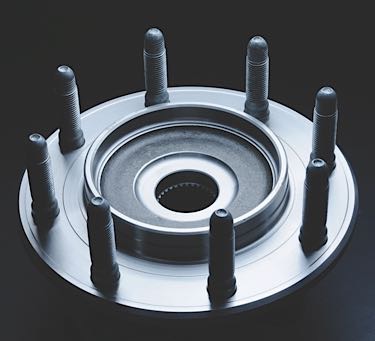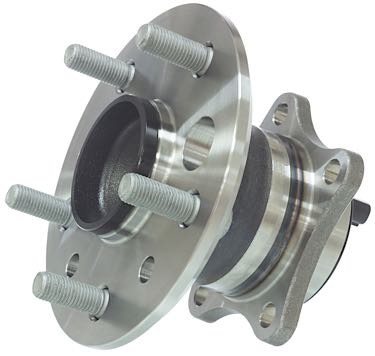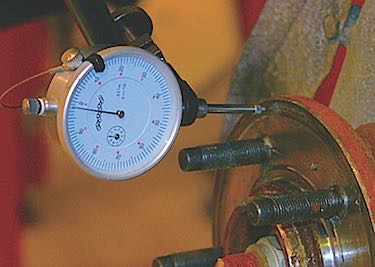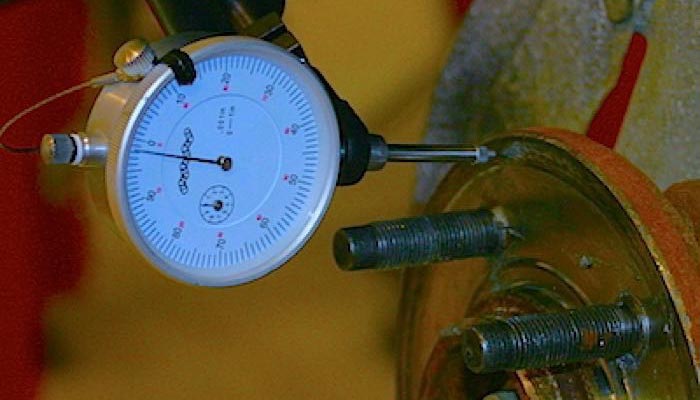 The hub flange is ground zero for pulsation problems. Runout in the flange will be magnified by the rotor. But, when do you replace a flange, stub axle or an entire hub unit? The answer can be confusing and will take some math and a micrometer.
The hub flange is ground zero for pulsation problems. Runout in the flange will be magnified by the rotor. But, when do you replace a flange, stub axle or an entire hub unit? The answer can be confusing and will take some math and a micrometer.
All flanges have some degree of runout. OEMs have tolerances both for the service specification and for manufacturing. Most vehicles can tolerate a certain amount of flange runout. Once it is above specifications, the driver experiences brake pedal pulsations. Runout below .01″ can’t be seen with the naked eye, so using a dial indicator as part of a brake job is the only way to observe runout.
How Did Damage Occur?
Flanges are damaged by curb strikes, installation errors or even corrosion. Extreme or catastrophic flange damage due to a curb strike is rare. But, some curb strikes can “tweak” the flange and cause runout. In most cases, the wheel and knuckle will deform before the flange or stub axle.
 If a hub or bearing is over-torqued, it can damage the flange and cause runout. It can also damage the bearings and the axle shaft. This type of runout can’t be corrected by retorquing the axle nut. The damage is permanent.
If a hub or bearing is over-torqued, it can damage the flange and cause runout. It can also damage the bearings and the axle shaft. This type of runout can’t be corrected by retorquing the axle nut. The damage is permanent.
Pitting and corrosion where the rotor mates to the flange can induce runout. If the corrosion is too great, replace the flange or bearing. Also, the flange can be damaged by excessive and uneven lug nut torque.
How Much Is Too Much?
When diagnosing runout in a flange, a few things have to be taken into consideration before replacement. First, think about the vehicle. On a small vehicle, .003” of runout in the flange may be too much. On a full-sized pickup, this may be acceptable. Some OEMs may have a specification and replacement criteria for the flange runout, but many do not. Always check for service information.
 Options
Options
If you are using an on-the-car brake lathe, there is only so much meat on the rotor to remove to compensate for lateral runout. If too much material is removed, it could create a rotor that is thermally unbalanced. This is not warping: A rotor that is not thermally balanced will have hot and cold spots that will change the friction levels and cause a brake judder.
Most on-the-car brake lathes with automatic runout compensation will not allow the user to continue if the amount of lateral runout is too large. Either the machine will cite an error with the rotor or the mounting of the lathe.
One option to save a flange is the rotor correction plate or shim. Flange runout can be corrected with tapered shims that are available to correct a runout of 0.003 inches (0.075 mm) to 0.009 inches (0.230 mm).
A runout of more than 0.005 inches (0.125 mm) at the bearing flange cannot be corrected by the use of a shim. The combination of rotor and bearing flange could prevent the rotor from being turned. You should check bearing flange runout after friction surface runout. Change the rotor position 180 degrees on the flange and check it. If the high spot changes 180 degrees, the rotor could be OK or be ready to turn after the bearing is shimmed.
Replacement
As a rule of thumb, runout greater than .005” for a light vehicle is a sign that the flange may be damaged or out of specification and further corrective action must be taken.
If all attempts have been made to correct runout, and it can’t be brought below .002” or the recommended specification, the final option is the replacement of the flange, stub axle or wheel bearing hub unit.














